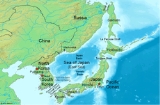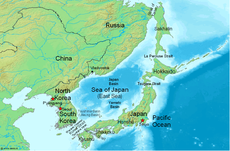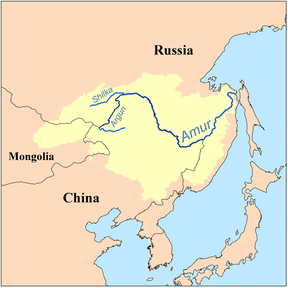
HLA-B48
Encyclopedia
| Alleles | B*4801 B*4802 B*4803 | |
| Structure (See HLA-B HLA-B HLA-B is a human gene that provides instructions for making a protein that plays a critical role in the immune system. HLA-B is part of a family of genes called the human leukocyte antigen complex... ) |
||
| Symbol(s) Human Genome Organisation The Human Genome Organisation is an organization involved in the Human Genome Project, a project about mapping the human genome. HUGO was established in 1989 as an international organization, primarily to foster collaboration between genome scientists around the world... |
HLA-B | |
| EBI-HLA European Bioinformatics Institute The European Bioinformatics Institute is a centre for research and services in bioinformatics, and is part of European Molecular Biology Laboratory... |
B*4801 | |
| EBI-HLA European Bioinformatics Institute The European Bioinformatics Institute is a centre for research and services in bioinformatics, and is part of European Molecular Biology Laboratory... |
B*4802 | |
| EBI-HLA European Bioinformatics Institute The European Bioinformatics Institute is a centre for research and services in bioinformatics, and is part of European Molecular Biology Laboratory... |
B*4803 | |
| Locus Locus (genetics) In the fields of genetics and genetic computation, a locus is the specific location of a gene or DNA sequence on a chromosome. A variant of the DNA sequence at a given locus is called an allele. The ordered list of loci known for a particular genome is called a genetic map... |
chr.6 Chromosome 6 (human) Chromosome 6 is one of the 23 pairs of chromosomes in humans. People normally have two copies of this chromosome. Chromosome 6 spans more than 170 million base pairs and represents between 5.5 and 6% of the total DNA in cells... 6p21.31 |
|
HLA-B48 (B48) is an HLA
Human leukocyte antigen
The human leukocyte antigen system is the name of the major histocompatibility complex in humans. The super locus contains a large number of genes related to immune system function in humans. This group of genes resides on chromosome 6, and encodes cell-surface antigen-presenting proteins and...
-B
HLA-B
HLA-B is a human gene that provides instructions for making a protein that plays a critical role in the immune system. HLA-B is part of a family of genes called the human leukocyte antigen complex...
serotype
Serotype
Serotype or serovar refers to distinct variations within a subspecies of bacteria or viruses. These microorganisms, viruses, or cells are classified together based on their cell surface antigens...
. The serotype identifies the more common HLA-B*48 gene products. B48 is most common along the West Pacific Rim, Americas indigeonous peoples and Northern Eurasians. B*4801 is part of a group of alleles including B*4201 that share Intron 1 sequence with B*0702, which is common over Western and Central Asia, and has a distribution indicating an early and long presence in Eurasian humans. A*48 appears to be the result of a recombination event that occurred early in the settlement history of Central Asia that then spread eastward into the NW Pacific rim and the New World. (For terminology help see: HLA-serotype tutorial)
Serotype
| B*48 | B48 | Other | Sample |
| allele | % | % | size (N) |
| 4801 | 78 | 10 | 610 |
| 4802 | 3 | 60 | 39 |
| 4803 | 66 | 13 | 32 |
Alleles
| freq | ||
| ref. | Population | (%) |
| Ami Ami The Amis are an indigenous people of Taiwan. They speak Amis, an Austronesian language, and are one of the thirteen officially recognized peoples of Taiwanese aborigines... (Taiwan Taiwan Taiwan , also known, especially in the past, as Formosa , is the largest island of the same-named island group of East Asia in the western Pacific Ocean and located off the southeastern coast of mainland China. The island forms over 99% of the current territory of the Republic of China following... ) |
26.0 | |
| Lama (Lamas, Peru Peru Peru , officially the Republic of Peru , is a country in western South America. It is bordered on the north by Ecuador and Colombia, on the east by Brazil, on the southeast by Bolivia, on the south by Chile, and on the west by the Pacific Ocean.... ) |
24.7 | |
| Chiriguanos (Argentina Argentina Argentina , officially the Argentine Republic , is the second largest country in South America by land area, after Brazil. It is constituted as a federation of 23 provinces and an autonomous city, Buenos Aires... ) |
21.7 | |
| Taroko (Taiwan) | 19.1 | |
| Atayal (Taiwan) | 17.0 | |
| Pima Pima The Pima are a group of American Indians living in an area consisting of what is now central and southern Arizona. The long name, "Akimel O'odham", means "river people". They are closely related to the Tohono O'odham and the Hia C-ed O'odham... (Arizona, USA) |
16.9 | |
| Nenets Nenets Nenets may refer to:*Nenets Autonomous Okrug, a federal subject of Russia*Yamalo-Nenets Autonomous Okrug, a federal subject of Russia*Nenets people, a Samoyedic people... (Russia Russia Russia or , officially known as both Russia and the Russian Federation , is a country in northern Eurasia. It is a federal semi-presidential republic, comprising 83 federal subjects... ) |
15.7 | |
| Yup'ik Eskimo (AK, USA) | 14.7 | |
| Toba Rosario (Argentina) | 13.4 | |
| Puyuma Puyuma The Puyuma , also known as the Peinan or Beinan tribe, are one of the tribal groups of the Taiwanese aborigines. The tribe is generally divided into the Chihpen and Nanwang groups, both resident in Taitung County on the east coast of Taiwan.... (Taiwan) |
12.0 | |
| Nivkhi (Sakhalin I., Russia) | 11.3 | |
| Samoa (USA) | 10.0 | |
| Canoncito Navajo (NM, USA) | 9.8 | |
| Tarahumara (Chihuahua, Mexico) | 9.1 | |
| Ivatan (N. Isles, Philippines) | 8.0 | |
| Ainu (Hokkaido, Japan) | 7.0 | |
| Rukai (Taiwan) | 7.0 | |
| Manchu (Harbin, China) | 5.8 | |
| Northern Han (China) | 5.7 | |
| Mongolia Khalha | 5.7 | |
| Taiwan Pazeh | 5.5 | |
| Beijing (China ) | 5.3 | |
| Inner Mongolia (China) | 4.9 | |
| Taiwan Siraya | 4.9 | |
| Tuva (2) (Russia) | 4.7 | |
| N. Korean (Harbin, China) | 4.5 | |
| Mayos (Mexico) | 4.5 | |
| Zaptotec (Oaxaca, Mexico) | 4.5 | |
| Japan (5) | 4.3 | |
| Tibet (China) | 4.1 | |
| Taiwan Tao | 4.0 | |
| Oold (Mongolia) | 3.9 | |
| South Korea (3) | 3.4 | |
| Linqu County (Shandong, China) | 3.3 | |
| Seri (Sonora, Mexico) | 3.0 | |
| Wanigela (Papua New Guinea) | 2.3 | |
| Lakota Sioux (S. Dakota, USA) | 2.2 | |
| Madang (Papua New Guinea) | 1.8 | |
| Kurds (Georgia Tibilisi) | 1.7 | |
| Southern Han (China) | 1.6 | |
| Rabaul (N. Britain, PNG) | 1.3 | |
| Thailand | 1.1 | |
| India North Hindus | 1.0 | |
| Saomi (murmansk, Russia) | 1.0 | |
| Pakistan Sindhi | 0.5 |
Haplotypes
There is a known haplotype that covers a distance from South America to SiberiaA*2402 : C*08 : B*4801 : DRB1*08 : DQA1*0401 : DQB1*0402
and maybe indicative of recent long range migration. This haplotype is found
in Peru, Mexico, Eskimos. The A*2402 : C*0801 : B*4801 sub-component is also
found in Asian Americans, Hispanic Americans, Indigeonous Taiwanese, Northern Philippines, Japanese, Orochon, Tibetians. The A-Cw-B component of the haplotype appears to have been conserved, however, equilibration of linkage to DR-DQ is more evident in Asian and Native American populations. The Cw*0803 allelic variant of this haplotype is found in Japan, Eskimos, Asian Americans, Hispanic Americans and Oaxacans. The oddity of the distribution is that, other than the Manchu of Northern China, the Chinese population is devoid of the major A24-B48 and A2-B48 haplotypes. This indicates gene-flow along the West Pacific Rim to the New World and across Siberia connecting Tibet and Japan. B48 is found higher in the Ainu and Nivkhi than Japanese.

A*0206 : C*0801 : B*4801 This haplotype is seen in the Taiwan aboriginal population, Okinawan, Japanese, Asian Americans, Orochon, Korean and Hispanic American populations.
This haplotype might be extended with DRB1*0407 : DQA1*0301 : DQB1*0302
The Cw8-B48-DRB1*0407-DQB1*0302 is found in the Peru Llamas and Japanese populations. However levels in Japan, given the declining gradient to the south, indicate these haplotypes are the result of admixing with Northern Jomon populations during the post-Jomon period.
The B*48 haplotypes indicate that the Sea of Japan
Sea of Japan
The Sea of Japan is a marginal sea of the western Pacific Ocean, between the Asian mainland, the Japanese archipelago and Sakhalin. It is bordered by Japan, North Korea, Russia and South Korea. Like the Mediterranean Sea, it has almost no tides due to its nearly complete enclosure from the Pacific...
region was a probable hot spot for both migration to the South and also to the New World.


